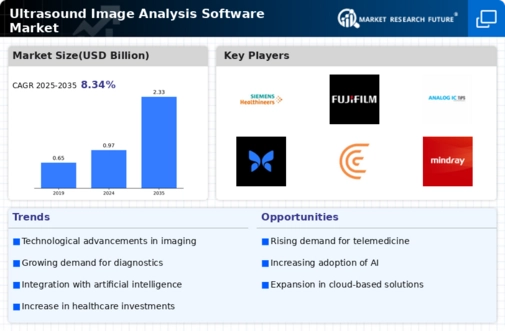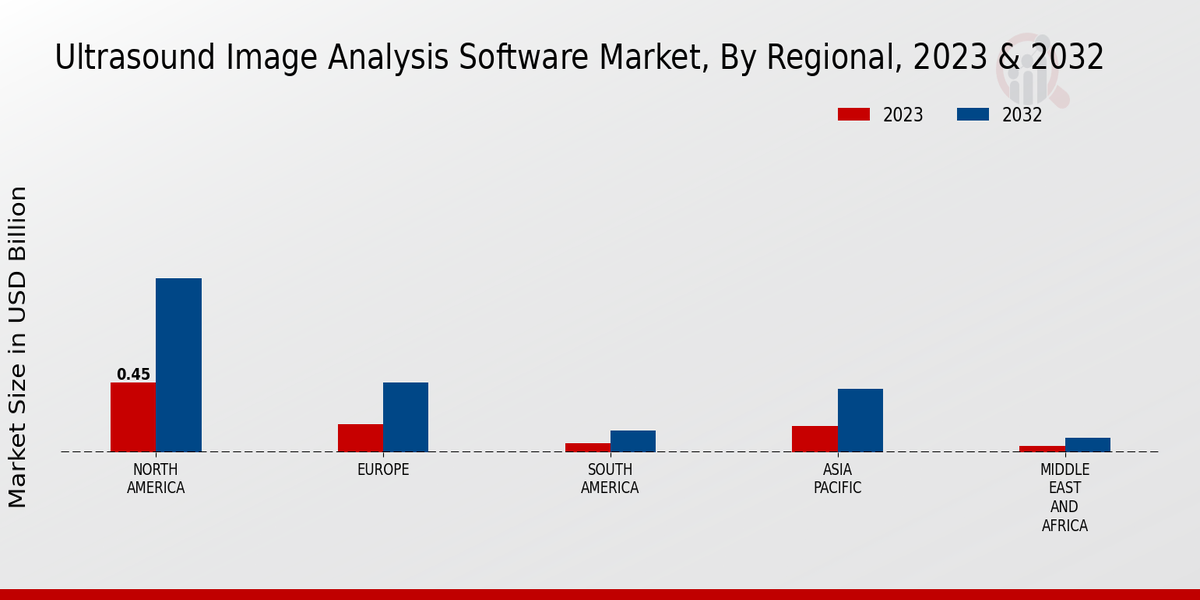Market Growth Projections
The Global Ultrasound Image Analysis Software Market Industry is projected to experience substantial growth, with estimates indicating an increase from 0.97 USD Billion in 2024 to 2.33 USD Billion by 2035. This growth trajectory suggests a compound annual growth rate of 8.29% from 2025 to 2035, highlighting the increasing adoption of ultrasound technologies across various healthcare settings. Factors contributing to this growth include technological advancements, rising demand for non-invasive procedures, and government support for healthcare initiatives. As the market evolves, it is likely to attract further investments and innovations, positioning ultrasound image analysis as a critical component of modern diagnostics.
Technological Advancements
The Global Ultrasound Image Analysis Software Market Industry is experiencing rapid technological advancements, which enhance the capabilities of ultrasound imaging. Innovations such as artificial intelligence and machine learning are being integrated into software solutions, allowing for improved image quality and diagnostic accuracy. These advancements are likely to drive market growth, as healthcare providers increasingly seek tools that can provide faster and more reliable results. The incorporation of advanced algorithms enables the software to assist in detecting anomalies that may be missed by the human eye, thus improving patient outcomes and operational efficiency.
Government Initiatives and Funding
Government initiatives aimed at improving healthcare infrastructure and access to diagnostic tools are positively influencing the Global Ultrasound Image Analysis Software Market Industry. Many countries are increasing funding for healthcare technologies, particularly in developing regions where access to advanced medical imaging is limited. These initiatives often include subsidies for healthcare facilities to adopt modern ultrasound technologies, thereby expanding the market. As governments recognize the importance of early diagnosis and treatment in improving health outcomes, the support for ultrasound imaging technologies is likely to grow, further driving market expansion.
Rising Incidence of Chronic Diseases
The increasing prevalence of chronic diseases globally is a significant driver for the Global Ultrasound Image Analysis Software Market Industry. Conditions such as cardiovascular diseases, diabetes, and cancer require regular monitoring and accurate diagnostics, which ultrasound imaging can provide. As the global population ages and the incidence of these diseases rises, healthcare providers are investing in advanced ultrasound technologies to enhance diagnostic capabilities. This trend is expected to contribute to a compound annual growth rate of 8.29% from 2025 to 2035, reflecting the urgent need for effective diagnostic tools in managing chronic health conditions.
Growing Awareness and Training Programs
The Global Ultrasound Image Analysis Software Market Industry is benefiting from increased awareness and training programs for healthcare professionals. As the importance of ultrasound imaging in diagnostics becomes more recognized, educational institutions and healthcare organizations are implementing training initiatives to enhance the skills of practitioners. This focus on education is likely to lead to a more proficient workforce capable of utilizing advanced ultrasound technologies effectively. Consequently, the demand for sophisticated ultrasound image analysis software is expected to rise, as trained professionals seek tools that can support their diagnostic efforts.
Increasing Demand for Non-Invasive Procedures
There is a growing preference for non-invasive diagnostic procedures among patients and healthcare providers, which is propelling the Global Ultrasound Image Analysis Software Market Industry. Ultrasound imaging is favored due to its safety, cost-effectiveness, and ability to provide real-time results without the need for ionizing radiation. As healthcare systems worldwide prioritize patient safety and comfort, the demand for ultrasound technologies is expected to rise. This trend is reflected in the projected market growth from 0.97 USD Billion in 2024 to 2.33 USD Billion by 2035, indicating a robust shift towards non-invasive diagnostic methods.









